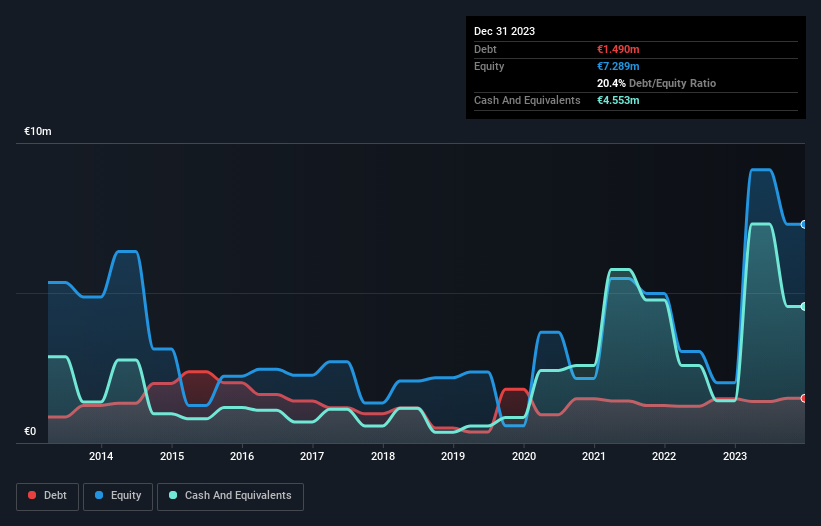
The external fund manager backed by Berkshire Hathaway's Charlie Munger, Li Lu, makes no bones about it when he says 'The biggest investment risk is not the volatility of prices, but whether you will suffer a permanent loss of capital.' When we think about how risky a company is, we always like to look at its use of debt, since debt overload can lead to ruin. We can see that Intrasense S.A. (EPA:ALINS) does use debt in its business. But should shareholders be worried about its use of debt?
When Is Debt A Problem?
Debt is a tool to help businesses grow, but if a business is incapable of paying off its lenders, then it exists at their mercy. Part and parcel of capitalism is the process of 'creative destruction' where failed businesses are mercilessly liquidated by their bankers. However, a more usual (but still expensive) situation is where a company must dilute shareholders at a cheap share price simply to get debt under control. Having said that, the most common situation is where a company manages its debt reasonably well - and to its own advantage. When we examine debt levels, we first consider both cash and debt levels, together.
Check out our latest analysis for Intrasense
What Is Intrasense's Net Debt?
The chart below, which you can click on for greater detail, shows that Intrasense had €1.49m in debt in December 2023; about the same as the year before. However, it does have €4.55m in cash offsetting this, leading to net cash of €3.06m.

A Look At Intrasense's Liabilities
Zooming in on the latest balance sheet data, we can see that Intrasense had liabilities of €1.84m due within 12 months and liabilities of €1.32m due beyond that. Offsetting this, it had €4.55m in cash and €609.0k in receivables that were due within 12 months. So it actually has €2.00m more liquid assets than total liabilities.
This surplus suggests that Intrasense is using debt in a way that is appears to be both safe and conservative. Because it has plenty of assets, it is unlikely to have trouble with its lenders. Simply put, the fact that Intrasense has more cash than debt is arguably a good indication that it can manage its debt safely. There's no doubt that we learn most about debt from the balance sheet. But you can't view debt in total isolation; since Intrasense will need earnings to service that debt. So if you're keen to discover more about its earnings, it might be worth checking out this graph of its long term earnings trend.
In the last year Intrasense had a loss before interest and tax, and actually shrunk its revenue by 13%, to €3.3m. We would much prefer see growth.
So How Risky Is Intrasense?
By their very nature companies that are losing money are more risky than those with a long history of profitability. And we do note that Intrasense had an earnings before interest and tax (EBIT) loss, over the last year. Indeed, in that time it burnt through €4.1m of cash and made a loss of €3.6m. But at least it has €3.06m on the balance sheet to spend on growth, near-term. Overall, its balance sheet doesn't seem overly risky, at the moment, but we're always cautious until we see the positive free cash flow. The balance sheet is clearly the area to focus on when you are analysing debt. However, not all investment risk resides within the balance sheet - far from it. For instance, we've identified 5 warning signs for Intrasense (2 are a bit unpleasant) you should be aware of.
If you're interested in investing in businesses that can grow profits without the burden of debt, then check out this free list of growing businesses that have net cash on the balance sheet.
New: AI Stock Screener & Alerts
Our new AI Stock Screener scans the market every day to uncover opportunities.
• Dividend Powerhouses (3%+ Yield)
• Undervalued Small Caps with Insider Buying
• High growth Tech and AI Companies
Or build your own from over 50 metrics.
Have feedback on this article? Concerned about the content? Get in touch with us directly. Alternatively, email editorial-team (at) simplywallst.com.
This article by Simply Wall St is general in nature. We provide commentary based on historical data and analyst forecasts only using an unbiased methodology and our articles are not intended to be financial advice. It does not constitute a recommendation to buy or sell any stock, and does not take account of your objectives, or your financial situation. We aim to bring you long-term focused analysis driven by fundamental data. Note that our analysis may not factor in the latest price-sensitive company announcements or qualitative material. Simply Wall St has no position in any stocks mentioned.
About ENXTPA:ALINS
Intrasense
Intrasense SA designs and develops software solution for advanced visualization and analysis of multimodality medical images under the Myrian name worldwide.
Moderate with mediocre balance sheet.
Market Insights
Community Narratives



